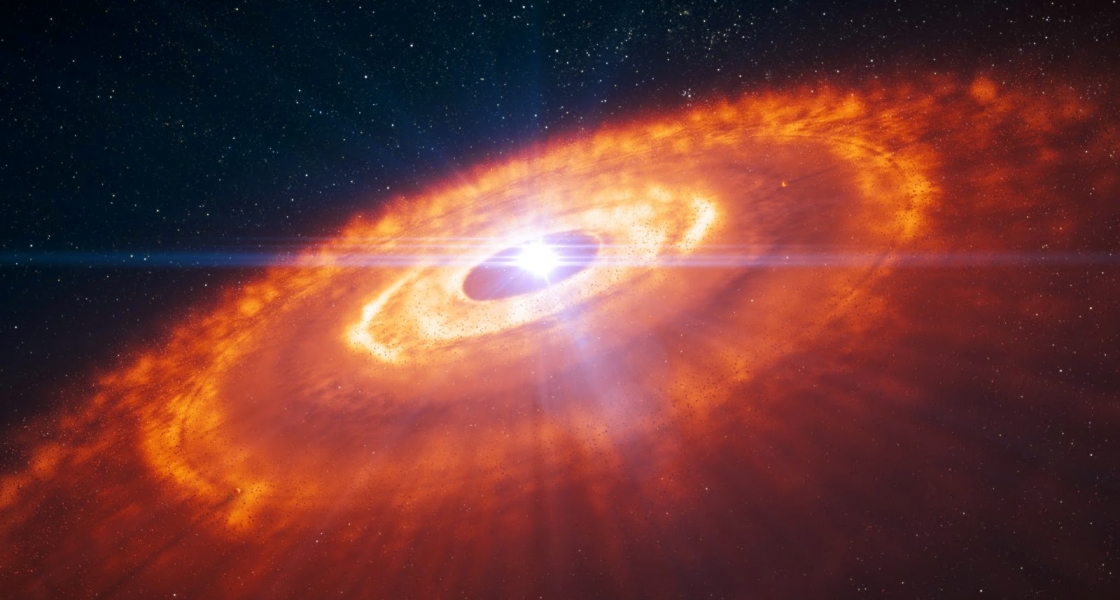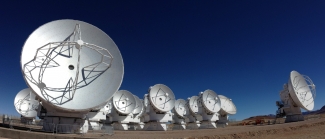Fellow Phil Armitage and his collaborator Jake Simon of the Southwest Research Institute recently conducted a theoretical study of turbulence in the outer reaches of an accretion disk around HD 163296, a nearby young star. Meanwhile, the Atacama large Millimeter/submillimeter Array (ALMA) in northern Chile observed the same accretion disk. There were intriguing and unexpected differences between what the theory predicted and what the observation revealed. As a result, theorists may need to rethink their understanding of the behavior of an accretion disk at great distances from the central star.
“The outer disks we’re interested in should have some sort of turbulence, some significant gas motion that departs from the simple rotation (of the disk),” said Simon. Simon explained that something has to remove the disk’s angular momentum to allow the gas to move towards the central star. Turbulence was, and still is, the primary explanation for how this happens. However, ALMA detected no clear evidence of turbulence in the outer disk.
“ALMA is a revolutionary instrument,” explained Armitage. He said people had predicted that ALMA would overturn some theoretical ideas, but he and Simon hadn’t expected it to be their ideas. Even so, he and Simon are excited that the new observations are giving them the opportunity to revisit their theory to account for the new observation. And, if this observation holds up with other planet-forming systems, it will be Simon and Armitage’s job to figure out exactly what’s going on.
Armitage said that there may be a period of confusion on both the observational and theoretical sides before it becomes clear what’s happening in the outer region of the accretion disk of HD 163296. An interesting part of this conundrum is that there are observations that clearly show material at 1 AU (the distance from the Sun to the Earth) flowing in and accreting onto the star. So something––quite likely turbulence––is removing the angular momentum in the inner disk regions.
However, at 100 AU (two and a half times the distance from the Sun to Pluto), there is no reason, in principle, that the gas has to be turbulent or flowing inward at all. The gas could just be sitting there orbiting the young star until it eventually gets blown away because of heating by x-rays or ultraviolet radiation from the star.
“The new observation is interesting, exciting, and more mysterious now than before.” said Armitage. “The issue here is not the precision of the measurements, which is extremely good, but how those measurements are interpreted.” He added that there are things in the Universe that may not work in quite the way people currently understand them. And, according to Armitage and Simon, this is the sort of mystery that makes it great fun to do theoretical astrophysics.––Julie Phillips




 The Physics Frontiers Centers (PFC) program supports university-based centers and institutes where the collective efforts of a larger group of individuals can enable transformational advances in the most promising research areas. The program is designed to foster major breakthroughs at the intellectual frontiers of physics by providing needed resources such as combinations of talents, skills, disciplines, and/or specialized infrastructure, not usually available to individual investigators or small groups, in an environment in which the collective efforts of the larger group can be shown to be seminal to promoting significant progress in the science and the education of students. PFCs also include creative, substantive activities aimed at enhancing education, broadening participation of traditionally underrepresented groups, and outreach to the scientific community and general public.
The Physics Frontiers Centers (PFC) program supports university-based centers and institutes where the collective efforts of a larger group of individuals can enable transformational advances in the most promising research areas. The program is designed to foster major breakthroughs at the intellectual frontiers of physics by providing needed resources such as combinations of talents, skills, disciplines, and/or specialized infrastructure, not usually available to individual investigators or small groups, in an environment in which the collective efforts of the larger group can be shown to be seminal to promoting significant progress in the science and the education of students. PFCs also include creative, substantive activities aimed at enhancing education, broadening participation of traditionally underrepresented groups, and outreach to the scientific community and general public.